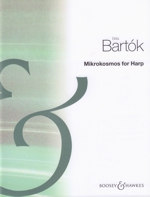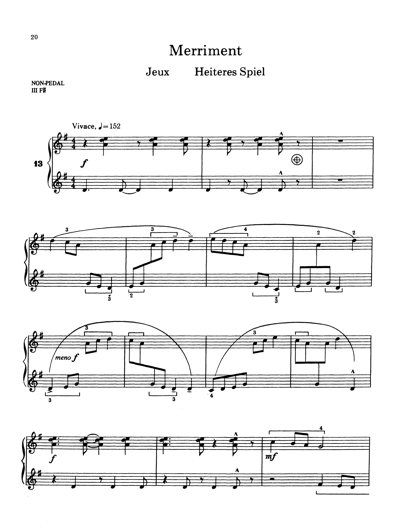 |
Mikrokosmos for Harp Bela Bartok ed. Marilyn S. Marzuki |
|
| Contents: | See contents below | |
| Instrumentation: | Lever / Pedal Harp | |
| Level: | Elementary - Intermediate Exam setting ABRSM Grade 2,3,4 (see contents) |
|
| Format: | 230 x 300mm stapled score | |
| ISMN: | 979-0-060-01193-1 | |
| Publisher: | Boosey & Hawkes | |
| Series: | -- | |
| Edition/Year: | 1940 Renewed 1967 Harp arrangements 1979 |
|
| Origin: | UK | |
| Our Ref: | UM0969 | |
Buy this music now £29.50 +p&p |
||
| Other music by Bela Bartok | ||
CONTENTS
Editor's Preface:
Bartok, The Mikrokosmos and the Harp
Performance Guidelines
Notes to the Melodies
Notation Guide
Tunes -
Solos:
1. With Alternate Hands
2. In Phrygian Mode ABRSM Grade 2, List B, Item 1 (choice)
3. In Yugoslav Mode ABRSM Grade 2, List B, Item 1 (choice)
4. Melody with Accompaniment
5. Meditation
6. Increasing — Diminishing
7. Waves
8. Unison Divided
9. In Oriental Style
10. Buzzing
11. Triplets ABRSM Grade 3, List B, Item 2 (choice)
12. Five-Tone Scale ABRSM Grade 3, List B, Item 2 (choice)
13. Merriment ABRSM Grade 4, List B, Item 1
Tunes - Ensembles:
14. Triplets in Lydian Mode
15. Melody Divided
16. Two Major Pentachords
17. Playsong
18. Melody in the Mist
19. Melody with Interruptions
20. Whole Tone Scale
Acknowledgments
Special tribute and gratitude to the Des Moines (Iowa) Harp Ensemble, directed by Sandra Bury, who premiered all seven of the ensemble pieces in this book at the 1978 Conference of the American Harp Society at Sioux Falls, South Dakota. Appreciation is extended to the following teachers who carefully studied the manuscript and offered invaluable suggestions: Sandra Bury, Linda I. Wellbaum, Elisa Dickon, Patricia Adams Harris and Kathryn Case Holm, and to Bill and Shirley Head and Sharon Phillips for their help. Thanks also to Dr. Benjamin Suchoff, successor trustee to the Estate of Bela Bartok and author of Guide to Bartbk's Mikrokosmos, for his invaluable guidance in preparing this publication. M. S. M.
Marilyn S. Marzuki is the author of numerous books, solos and articles for the harp; she is a noted choral composer/arranger as well. Her B.M. and M.M. degrees in Harp Performance and Music Literature are from the Eastman School of Music; her major teachers were Alice Chalifoux, Eileen Malone and Linda Wellbaum. Her varied career has ranged from principal and solo harpist with symphony orchestras in the United States and Canada to harp/ piano college professorships to choral publications director with music publishing companies. She is on the national board of directors of the American Harp Society and is listed in OUTSTANDING YOUNG WOMEN IN AMERICA and WHO'S WHO IN FLORIDA.
EDITOR'S PREFACE
BARTOK, THE MIKROKOSMOS AND THE HARP
Bela Bartok (1881-1945), Hungarian composer and ethnomusicologist, was also active as a concert pianist and teacher. MIKROKOSMOS, a set of 153 progressive piano study pieces in six volumes, is one of his major works and has become a staple in the training of pianists. Harpists too can greatly benefit from the study of this music.
In MIKROKOSMOS and throughout much of his music, Bartok incorporated numerous Eastern European folk melodies (which he recorded during many field trips into rural areas) as well as original melodies cast in their mold. He frequently used ancient modes rather than the customary major and minor, and also constructed modes of his own: e.g., minor mode with a lowered fifth degree, or Mixolydian mode with a raised fourth degree, etc.
Among the benefits to be derived by harpists from the study of Bartok's music are:
1. Strengthening of rhythmic ability: Bartok's unpredictability stimulates alertness and reinforces the necessity to count.
2. Exposure to contemporary music: The "feel" for new music comes easily when it is introduced early. Working with mixed meters, scale systems other than major/minor (modes, whole tone and pentatonic scales, etc.), irregular phrases, syncopation, polyrhythms, etc., broadens the harpist's knowledge of music beyond the traditional. It therefore enhances the ability to perform and teach contemporary music.
3. Ensemble experience: Harpists need more of this at the early level in order to be better prepared to play orchestral, band and chamber music and to accompany soloists. It heightens the awareness of the need to count. Besides, it's fun!
4. Independence of the hands: Bartok gives both hands equally important roles, requiring each to perform on its own with commensurate strength.
5. Sightreading: This skill is acquired only through daily effort. The collection provides excellent sightreading material for intermediate and advanced players.
More than technical ability is needed to discover the essence of Bartok's music and to carry out his intentions. It is recommended that users of this book listen to Bartok's music and read about the man and his art. Live performances or recordings of CONCERTO FOR ORCHESTRA and MUSIC FOR STRINGS, PERCUSSION AND CELESTA are especially interesting, not only because of the importance of these works, but also because of their extraordinary use of the harp.
Many technical terms used throughout this book are purposely left undefined in the hope that harpists will use them as a springboard into the fascinating study of music theory and history.
It is suggested that harpists who also play piano become acquainted with the MIKROKOSMOS in its entirety for a fuller insight into the works of one of the greatest composers of the twentieth century.
